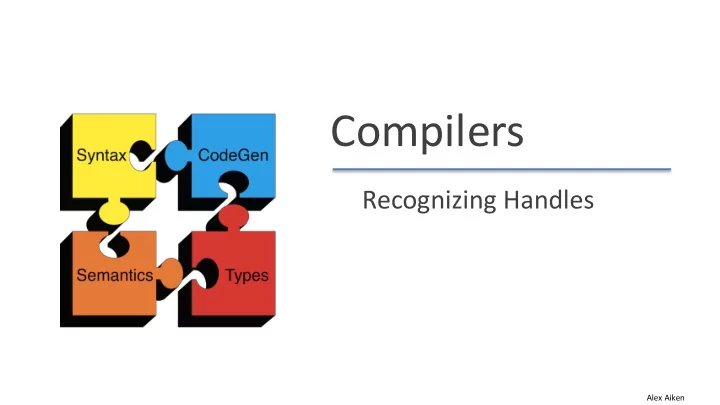

Compilers Recognizing Handles Alex Aiken
Recognizing Handles • Bad News – There are no known efficient algorithms to recognize handles • Good News – There are good heuristics for guessing handles – On some CFGs, the heuristics always guess correctly Alex Aiken
Recognizing Handles All CFGs Unambiguous CFGs LR(k) CFGs LALR(k) CFGs SLR(k) CFGs Alex Aiken
Recognizing Handles • It is not obvious how to detect handles • At each step the parser sees only the stack, not the entire input; start with that . . . a is a viable prefix if there is an w such that a | w is a state of a shift-reduce parser Alex Aiken
Recognizing Handles • What does this mean? A few things: – A viable prefix does not extend past the right end of the handle – It’s a viable prefix because it is a prefix of the handle – As long as a parser has viable prefixes on the stack no parsing error has been detected Alex Aiken
Recognizing Handles Important Fact #3 about bottom-up parsing: For any grammar, the set of viable prefixes is a regular language Alex Aiken
Recognizing Handles • Important Fact #3 is non-obvious • We show how to compute automata that accept viable prefixes Alex Aiken
Recognizing Handles • An item is a production with a “ . ” somewhere on the rhs • The items for T (E) are T .(E) T (.E) T (E.) T (E). Alex Aiken
Recognizing Handles • The only item for X e is X . • Items are often called “LR(0) items” Alex Aiken
Recognizing Handles • The problem in recognizing viable prefixes is that the stack has only bits and pieces of the rhs of productions – If it had a complete rhs, we could reduce • These bits and pieces are always prefixes of rhs of productions Alex Aiken
Recognizing Handles Consider the input (int) E T + E | T T int * T | int | (E) – Then (E|) is a state of a shift-reduce parse – (E is a prefix of the rhs of T (E) • Will be reduced after the next shift – Item T (E.) says that so far we have seen (E of this production and hope to see ) Alex Aiken
Recognizing Handles • The stack may have many prefixes of rhs’s Prefix 1 Prefix 2 . . . Prefix n-1 Prefix n • Let Prefix i be a prefix of rhs of X i a i – Prefix i will eventually reduce to X i – The missing part of a i-1 starts with X i – i.e. there is a X i-1 Prefix i-1 X i b for some b • Recursively, Prefix k+1 …Prefix n eventually reduces to the missing part of a k Alex Aiken
Recognizing Handles Consider the string (int * int): (int *|int) is a state of a shift-reduce parse “ ( ” is a prefix of the rhs of T (E) “ e ” is a prefix of the rhs of E T “ int * ” is a prefix of the rhs of T int * T Alex Aiken
Recognizing Handles The “stack of items” T (.E) E .T T int * .T Says We’ve seen “ ( ” of T (E) We’ve seen e of E T We’ve seen int * of T int * T Alex Aiken
Recognizing Handles Idea: To recognize viable prefixes, we must – Recognize a sequence of partial rhs’s of productions, where – Each partial rhs can eventually reduce to part of the missing suffix of its predecessor Alex Aiken
Recommend
More recommend